Spinal cord injury survivors often heavily rely their shoulders and upper extremities for function and mobility, making them susceptible to injury or pain. Depending on the severity or level of the spinal cord injury, some survivors may also experience weakness or immobility in the shoulders. If the shoulders are neglected for too long, it can increase the risk of other complications such as joint contractures, neuropathic pain, or spasticity.
Therefore, movement, shoulder health, and injury prevention are crucial. Practicing shoulder exercises consistently can help improve strength, increase range of motion, relieve stiff muscles, and reduce pain. This article will discuss some of the most effective spinal cord injury shoulder exercises you can try with your therapist or at home.
To have a better understanding how these exercises are beneficial, it’s important to understand how a spinal cord injury affects the shoulders and muscles.
How a Spinal Cord Injury Affects the Shoulder Muscles

The presence of shoulder pain and weakness often depends on the type of spinal cord injury (complete or incomplete) and the level of injury. Typically, movement and/or sensation below the level of spinal cord injury are affected.
For example, an injury at C5 or higher causes weakness in the shoulders. With a C6 level of spinal cord injury or lower, the shoulders may not be directly impacted. However, many may still struggle with weakness or paralysis in the legs, potentially requiring the use of a wheelchair. As such, the arm and shoulder muscles may become overworked during wheelchair use, possibly resulting in pain or injury.
Fortunately, exercise can help reduce pain and improve muscle strength and mobility in the shoulders. Exercise stimulates the spinal cord and activates neuroplasticity, the nervous system’s ability to heal and rewire itself. Neuroplasticity is most effective through high repetition of exercises, or massed practice. The more you practice, the higher the chances of rebuilding shoulder muscle strength and increasing movement.
Not only does exercise activate neuroplasticity, but it also directly increases or maintains lean muscle mass, strength, and mobility. Furthermore, exercise can also help prevent other shoulder complications such as joint subluxation (partial dislocation) or other conditions.
Therefore it’s essential to find the most suitable spinal cord injury shoulder exercises for you. You should consult with your physical therapist to make sure they are safe for you, and you can also ask your therapist for more exercise recommendations to match your specific needs or goals.
Performing SCI Shoulder Exercises Safely in a Wheelchair
As previously mentioned, a lower-level spinal cord injury (typically T2 or lower) doesn’t usually affect the upper body. However, some may still experience shoulder pain due to overuse of the muscles, particularly survivors with paraplegia who must rely on their upper extremities for wheelchair propulsion, transfers, and reaching overhead especially during activities of daily living.
Shoulder pain in SCI survivors is commonly due to injured rotator cuff muscles or tendons. The rotator cuff is a group of four primary muscles (supraspinatus, infraspinatus, teres minor, and subscapularis) and provide support to the shoulders to stabilize the shoulder joint and help it move properly.
With inappropriate shoulder mechanics, the rotator cuff, specifically the supraspinatus tendon, can become overcrowded or pinched (impingement syndrome). This condition can be painful and can cause further wear and tear of the tendon.
Spinal cord injury shoulder exercises can help reduce pain and strengthen the tendons. However, because the shoulders are being used excessively, it’s crucial NOT to overwork them even more. Performing daily activities should not feel overly strenuous or create more pain.
Working with physical and occupational therapists is important because they can provide realistic solutions to perform daily tasks more comfortably, while you work on improving your strength.
In addition, do not underestimate the value of incorporating rest in order to prevent and allow recovery time for overuse injuries in the shoulder. It is important to recognize that rest does not mean the same as disuse or neglect of the upper extremities. Instead, rest could mean a relative reduction of stress on the shoulder or taking breaks during repetitive tasks such as propelling a manual wheelchair.
Once cleared by your therapist, you can try the following spinal cord injury shoulder exercises to boost mobility. Just be sure to take precautions such as taking necessary breaks and stopping immediately if you feel fatigued or any pain or discomfort.
11 Spinal Cord Injury Shoulder Exercises to Boost Mobility
Spinal cord injury shoulder exercises can be done passively or actively depending on the severity of the injury and your ability level. Passive exercise involves assisting your affected muscles through a movement. You can use your unaffected side to assist you or a trained caregiver or therapist can help.
Active exercise involves making the movement on your own and is usually done without assistance. Both passive and active exercise helps stimulate neuroplasticity in the spinal cord, promote circulation, and improve range of motion.
You should start with slow, controlled movements and work your way up to more challenging exercises. It is always recommended to consult with your therapist before adding weight or resistance during these shoulder exercises.
Here are 11 spinal cord injury shoulder exercises to help boost strength and mobility:
1. Arm Circles
For this first SCI shoulder exercise, spread your arms out to the sides to create a “T” shape. Then, move your arms in circular motions going forward and backward. Alternate each arm making small and large circles. This can help promote range of motion in your shoulder joints.
2. Snow Angels

Start by sitting up straight in your chair; or, you can also do this exercise lying flat on your back. Bend your elbows at a 90° angle and have your forearms facing forward. Slowly reach your arms overhead while keeping the elbows bent, then gently back down as though you are making snow angels. This exercise will help with shoulder mobility while the rotator cuff muscles work to control the movement.
3. Chest/Pectoral Stretch
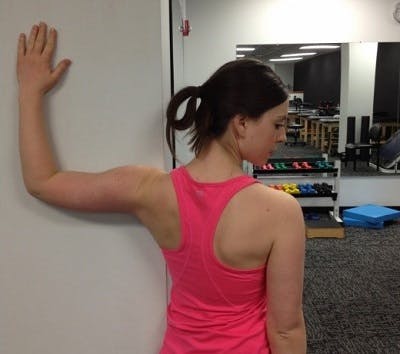
Hold one arm straight out to the side and lean the inner part of that arm against a wall. Slowly turn your body in the opposite direction (i.e. if your right arm is against the wall, your body should turn left). Hold for 30 seconds and then stretch out your other arm. Stretching can help relieve tightness in the chest and shoulders, which can also improve posture.
4. Arm Across Chest

Wrap one arm across the chest and use your other arm for support. Hold for about 20-30 seconds and then switch arms. Repeating this stretch can help improve range of motion in the shoulder joint and flexibility in your deltoids.
5. Overhead Tricep and Lats Stretch

To stretch the triceps and latissimus dorsi (or “lats”), bend one arm behind your head and use your other arm to gently press the elbow back (you can think of it as lining your elbow with your head). Keep your chest up as you hold for about 30 seconds, then release and switch arms. This stretch will help maintain the mobility necessary for overhead reaching.
6. Shoulder Blade Squeezes
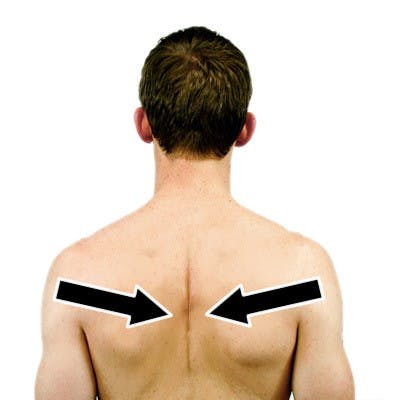
First, take a deep breath as you lift your chest and sit upright. Then, move your arms back, squeezing the shoulder blades together down and back. You should feel a slight stretch in the front of the shoulders, upper back and across your chest. Aim for 10 repetitions with 3 to 5 second holds. This exercise is beneficial for shoulder and upper extremity mobility because it helps with movements used in daily activities such as pushing, pulling, and holding objects, along with improving posture.
7. Shoulder Shrugs
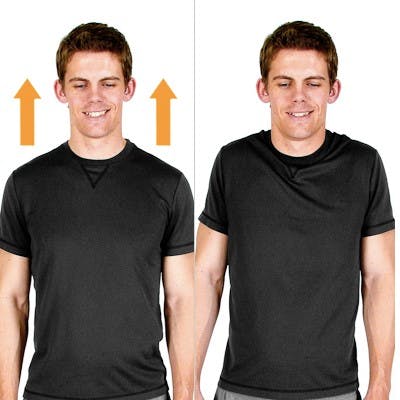
To practice shoulder shrugs, lift your shoulder blades up towards your ears, and then slowly lower them. Repeat about 10 times. To increase the challenge, try holding the shrug a few seconds longer or hold a light weight in each hand. This shoulder exercise can help strengthen your trapezius (upper back) muscle, which is responsible for shoulder blade mobility and stability.
8. Shoulder Rolls

After mastering shoulder shrugs and shoulder blade squeezes, you can try combining the motion into shoulder rolls by rotating your shoulders forward and backward in a circular motion. Aim to do 5 forward shoulder rolls followed by 10 backward shoulder rolls.
The forward motion in shoulder rolls is similar to that of pushing a wheelchair. Since many SCI survivors in a wheelchair already practice rolling their shoulders forward, it can be beneficial to focus on backward shoulder rolls. Shoulder rolls help loosen up tight muscles, improve coordination of the shoulder blades, and develop better posture.
9. Seated Upper Back Stretch
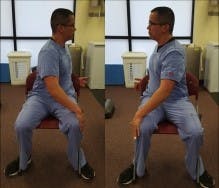
Before getting started, make sure that the brakes on your wheelchair are set and your feet are flat on the ground. Place one hand on your armrest and one on the outside of your knee or thigh. Then, gently press down with your hands as you slowly rotate your shoulders and trunk. Keep your chest upright as you breathe deeply and hold for about 15 seconds. Repeat for both sides. Upper back stretches are great for improving posture, lowering muscle tension, and reducing stiffness.
10. Half Jumping Jacks

Carefully swing your arms above your head and bring them back down, making jumping jack motions with your arms. This helps promote shoulder abduction, which is the ability to lift your arms away from your body. As well as adduction, lowering your arms back down towards your body. You can do sets of 10 to 20 repetitions, or go for intervals of 30 seconds at a time.
11. Punches
For this last spinal cord injury shoulder exercise, get into a seated position or try to position yourself in your wheelchair. Turn diagonally ensuring that one arm is facing forward and the other one is behind you. Then, slowly throw 10 punches straight forward, alternating with each arm. For an added challenge, change your target. For example, throw 10 punches upward, 10 punches downward, and 10 punches diagonally. This is a great way to work out your shoulder and trunk muscles.
Any shoulder exercise can be done actively or passively with the assistance of your therapist or trained caregiver. Practicing consistently is a key component in rehabilitation after SCI. Also, continue to increase the challenge of your exercises as you improve.
How You Push the Wheelchair Matters
For manual wheelchair users, spinal cord injury survivors utilize their upper extremities to propel themselves. While this activity itself develops outstanding shoulder strength over time, it also puts survivors at risk for overuse injuries if done excessively or with improper body mechanics. Having a properly fit wheelchair, as well as practicing optimal push stroke technique, can significantly reduce the risk of shoulder injury and pain.
First and foremost, it is always best to have a custom wheelchair that is designed to meet your specific size measurements and needs. Work directly with your therapist, an assistive technology professional, and/or the wheelchair vendor to make sure you have a proper fit to optimize comfort, function, and performance.
For example, adjusting the rear axle as far forward as possible without compromising wheelchair stability allows for more efficient propulsion. When the hand is placed at top dead-center on the pushrim, the angle between the upper arm and forearm should be between 100- 120 degrees.
When it comes to push patterns, wheelchair users have been observed to demonstrate four primary techniques:
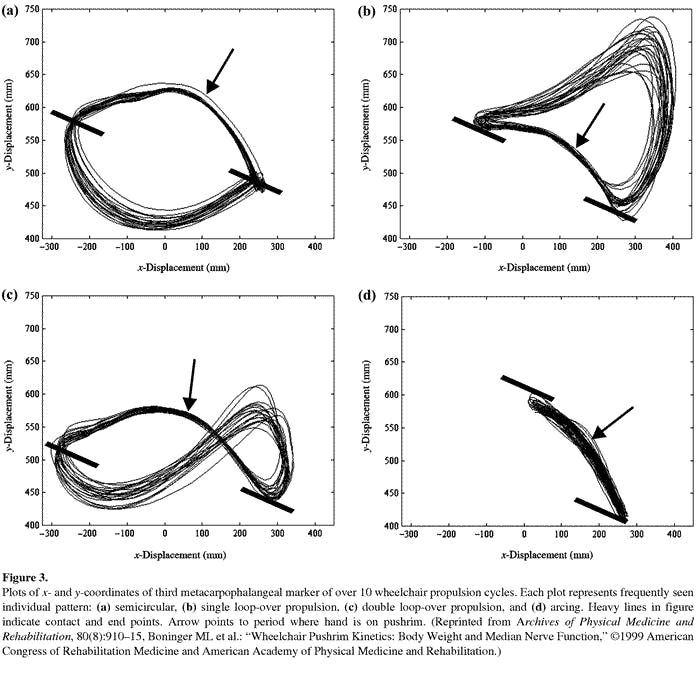
Image source: Archives of physical medicine and rehabilitation
According to the research, implementing a “semicircular or oval” shape push pattern (the top left pattern in the image above) encourages better shoulder biomechanics and avoids putting the shoulder joint in a compromised position. It is also important to practice propelling the wheelchair using long, smooth push strokes.
These strategies take a lot of practice and patience. It is recommended that you work together with your therapist to ensure you have the appropriate wheelchair fit and push mechanics to maintain shoulder health and reduce injury risk.
Practicing Shoulder Exercises After Spinal Cord Injury
A spinal cord injury can often cause shoulder pain or weakness, especially in individuals who use their arms constantly to move their wheelchair. To prevent further injury or complications, it’s important to perform shoulder exercises after spinal cord injury.
However, it’s also imperative not to overwork your shoulder muscles while exercising. Your therapist can provide more guidance regarding the types of SCI shoulder exercises you should do based on your ability level.
We hope this article encourages you to practice shoulder exercises after spinal cord injury to boost upper extremity strength and mobility.











